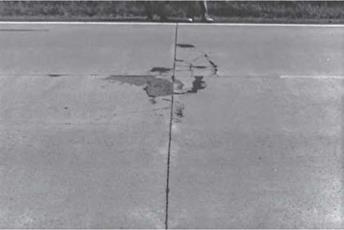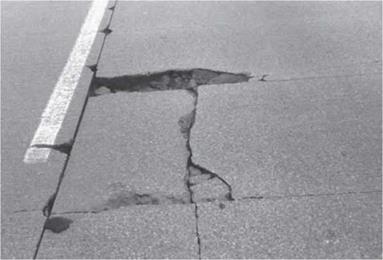Continuously Reinforced Rigid Pavement Distress—Visual Rating
Continuously reinforced concrete pavement deterioration is exhibited by the same distresses discussed for jointed concrete pavement along with the following additional considerations.
Settlement. As previously stated, settlement as displayed by a depression in the profile of the pavement affects the smoothness of a pavement. It may be the result of poor construction practice such as poor compaction over a utility, poor grade control during final grading of the subgrade, or localized soil conditions that cannot resist additional overburden or increased loading. Repair methods consist of replacement to the corrected profile or an overlay. However, settlements are more predominant in CRC pavement, because transverse cracks are inherently more numerous. With the transverse cracking at a spacing of 5 to 8 ft (1.5 to 2.4 m), the pavement is able to bend more freely and does not bridge weak foundations as effectively.
|
FIGURE 3.28 Example of corner break in jointed rigid pavement. |
Trans-verse Cracking. Although CRC pavement is designed to have transverse
cracks, the cracks should be spaced properly. Transverse cracks spaced too closely (less than 3 ft (0.9 m), as illustrated in Fig. 3.29) have a good chance of interconnecting, because they do not form uniformly straight and perpendicular to the centerline. Thus, as they interconnect, spalling will occur and pavement failures will result. On the other hand, transverse cracks spaced too far apart create higher stresses than the reinforcement can tolerate, and this can also result in pavement failures. Although
|
|
|
FIGURE 3.30 Example of punchout in continuously reinforced rigid pavement. |
|
|
incorrect transverse crack spacing is not a distress by itself, it must be monitored to help pavement engineers predict failures. Once failures are evident, they must be repaired by full-depth pavement removal and replacement. It is important to reestablish continuity of the reinforcement within the repair.
Punchouts. Figure 3.30 shows a punchout in a CRC pavement. A punchout is formed by the combination of intersecting transverse and longitudinal cracks over an area of weak foundation.










Leave a reply